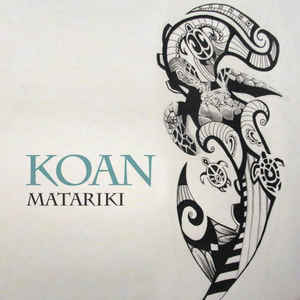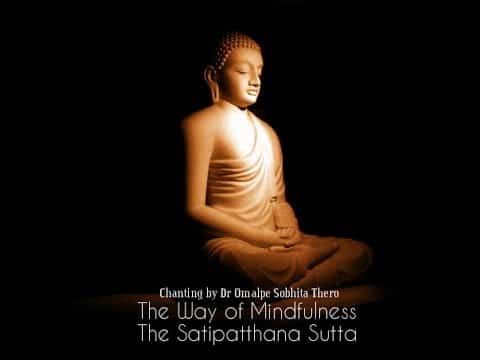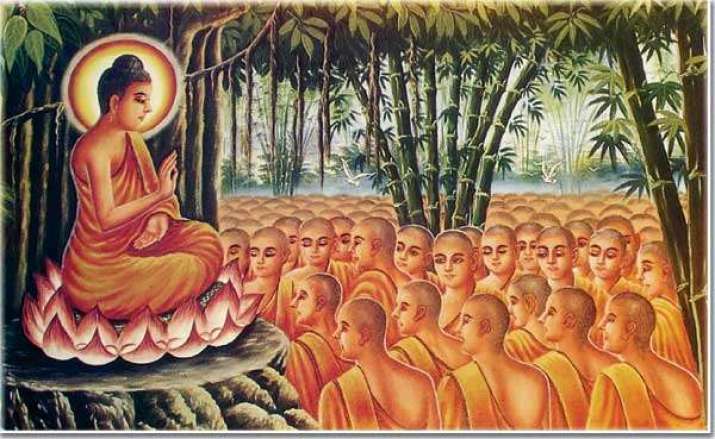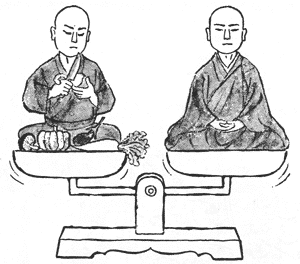The koan system is a unique and traditional teaching method of Zen Buddhism. Koan is a Japanese word that comes from the Chinese, kung-an, literally “public notice,” or “public announcement”. Japanese Koan, in Zen Buddhism of Japan, is a succinct paradoxical statement or question used as a meditation discipline for novices, particularly in the Rinzai sect, but is also used in the Soto school. The effort to “solve” a koan is intended to exhaust the analytic intellect and the egoistic will, readying the mind to entertain an appropriate response on the intuitive level. Each such exercise constitutes both a communication of some aspect of Zen experience and a test of the novice’s competence.
Koans are based on anecdotes of Zen (Chinese: Ch’an) masters. They often recount an encounter between master and disciple, where the master’s response or question is said to reveal the deep nature of things as they are. Successive generations of teachers have related these encounters to their students to illustrate particular principles of Zen. Questions or problems, often paradoxical, highlighted by each story were presented to encourage and test them in their training. The koan system enables the Zen teacher to test the individual student’s understanding of Zen, not intellectually, but as it applies to the student’s own life.
Koan practice is a form of practice that requires the supervision of a recognized teacher who has himself or herself gone through this rigorous training. Koans are an advanced tool, and have no inherent power in and of themselves, but can be very enlightening when used properly.
The koan is a reference to examples that are meant to guide life; or in the case of Zen, these dictates are meant to be catalysts for awakening one’s true/deep/pure nature.
Koans should only be used after one’s meditation has entered Samadhi. Samadhi is the condition of one’s mind when all the silt and ripples (ideas, thoughts, feelings, judgments) have quieted and the mind has become clear, calm, clean, naturally reflective and free-flowing in this moment. If the mind has not yet achieved Samadhi, don’t bother with koans. Koans deliberately stir up the waters of the mind, and if the mind is already disturbed, koan practice will only make things worse. If the mind is practiced at a given level of Samadhi, then a koan can be used to stretch one’s Samadhi-mind to a bigger dimension. By resolving a koan, that is to say encompassing the example/dictate/question with one’s understanding, small mind is slowly or suddenly stretched and awakened into Big Mind.
Koans are NOT answered. Any descriptive response, yes/no response, or this/that response will be rejected. When the deep meaning of the koan is understood directly, then a token of that understanding is easy to present. Usually no words are necessary, some poetic or creative gesture will suffice. This is why it is said that koans are not answered, but resolved. To work on a koan is to let a koan work on you.
We do not need to waste any time trying to figure the koan out. We have to let it in and make no effort to solve it. Any analysis is a waste of time, and at best will produce an intellectual or a pseudo-Zen response. Koans are a devilish instrument because they deliberately tempt us to make an interpretation, explanation, imitation or analysis; and yet, it is only when we exhaust or give up these lines of investigation that a deeper level of inquiry becomes possible. Often, only when we are able to admit in frustration that we don’t know anything, can true koan practice begin.
There are said to be 1,700 koans in all. The two major collections are the Pi-yen lu (Chinese: “Blue Cliff Records”; Japanese: Hekigan-roku), consisting of 100 koans selected and commented on by a Chinese priest, Yüan-wu, in 1125 on the basis of an earlier compilation; and the Wu-men kuan (Japanese: Mumon-kan), a collection of 48 koans compiled in 1228 by the Chinese priest Hui-k’ai (known also as Wu-men).
Though few Soto practitioners concentrate on koans during meditation, the Soto sect has a strong historical connection with koans, since many koan collections were compiled by Soto priests.
During the 13th century, Dōgen, founder of the Soto sect in Japan, quoted 580 koans in his teachings. He compiled some 300 koans in the volumes known as the Greater Shōbōgenzō. Dōgen wrote of Genjokoan, which points out that everyday life experience is the fundamental koan.
Examples of traditional koans:
“What is Buddha?” and its answer, “Three pounds of flax.”
***
Does a dog have Buddha-nature?
(A monk asked Zhàozhōu, “Does a dog have Buddha-nature or not?” Zhaozhou said, “Wú”.)
***
The sound of one hand.
(Two hands clap and there is a sound. What is the sound of one hand? — Hakuin Ekaku)
***
Original Face.
(Huìnéng asked Hui Ming, “Without thinking of good or evil, show me your original face before your mother and father were born.” )
***
Killing the Buddha.
(If you meet the Buddha, kill him. — Linji )
***
Baso said to a monk, “If I see you have a staff, I will give it to you. If I see you have no staff, I will take it away from you.
***
Wakuan stood in front of a picture of Bodhidharma. In the picture, Bodhidharma was wearing a beard. “Now, why doesn’t that fellow wear a beard?” asked Wakuan.
***
Sometimes, the koan stories describe strange actions of medieval Chinese monks who in one way or another became “deeply enlightened”. Zen Buddhist koans are stories about nothing else but enlightenment.
photo credit: mikosmile




